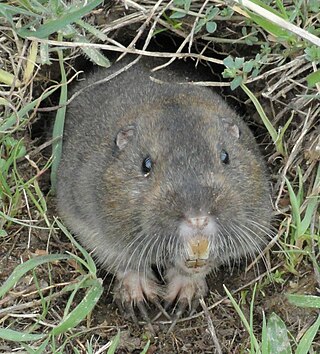
Pocket gophers, commonly referred to simply as gophers, are burrowing rodents of the family Geomyidae. The roughly 41 species are all endemic to North and Central America. They are commonly known for their extensive tunneling activities and their ability to destroy farms and gardens.

Botta's pocket gopher is a pocket gopher native to western North America. It is also known in some areas as valley pocket gopher, particularly in California. Both the specific and common names of this species honor Paul-Émile Botta, a naturalist and archaeologist who collected mammals in California in 1827 and 1828.
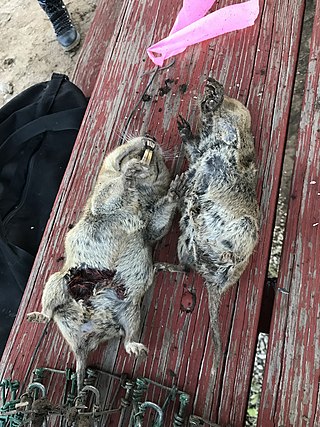
The yellow-faced pocket gopher is a species of pocket gopher that is native to shortgrass prairies in the south-western United States and northern Mexico. It is the species that lives north of the Southern Coahuila Filter-Barrier (SCFB). Among the different species, the yellow-faced pocket gopher has a small to medium-sized skull. The fossil of this genus was recorded from the pre-Pleistocene Benson Beds of Arizona.
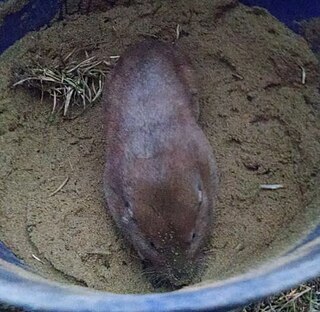
The southeastern pocket gopher is a species of pocket gopher that is native to the southeastern United States. It occurs in Alabama, Georgia, and Florida, where it is the only pocket gopher.

The genus Geomys contains 12 species of pocket gophers often collectively referred to as the eastern pocket gophers. Like all pocket gophers, members of this genus are fossorial herbivores.

The desert pocket gopher is a species of rodent in the family Geomyidae. It is found in the state of Chihuahua in Mexico and in Texas and New Mexico in the United States.
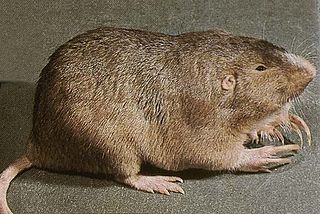
The plains pocket gopher is one of 35 species of pocket gophers, so named in reference to their externally located, fur-lined cheek pouches. They are burrowing animals, found in grasslands and agricultural land across the Great Plains of North America, from Manitoba to Texas. Pocket gophers are the most highly fossorial rodents found in North America.
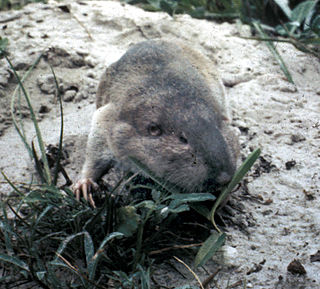
The Texas pocket gopher is a species of rodent in the family Geomyidae. It is found in Tamaulipas in Mexico and in Texas in the United States.
Buller's pocket gopher is a species of gopher that is endemic to Mexico.

The camas pocket gopher, also known as the camas rat or Willamette Valley gopher, is a rodent, the largest member in the genus Thomomys, of the family Geomyidae. First described in 1829, it is endemic to the Willamette Valley of northwestern Oregon in the United States. The herbivorous gopher forages for vegetable and plant matter, which it collects in large, fur-lined, external cheek pouches. Surplus food is hoarded in an extensive system of tunnels. The dull-brown-to-lead-gray coat changes color and texture over the year. The mammal's characteristically large, protuberant incisors are well adapted for use in tunnel construction, particularly in the hard clay soils of the Willamette Valley. The gophers make chattering sounds with their teeth; males and females make purring sounds when they are together, and the young make twittering sounds. Born toothless, blind and hairless, the young grow rapidly before being weaned at about six weeks of age.

The mountain pocket gopher is a species of rodent in the family Geomyidae. It is endemic to California and Nevada. The Sierra Nevada are part of its range.

Baird's pocket gopher or the Louisiana pocket gopher is a species of pocket gopher that is native to the southern United States. In total, there are three almost identical species of eastern pocket gopher; Geomys attwateri, G. bursarius, and G. breviceps. G. breviceps is larger in size, G. attwateri is medium-sized and G. bursarius is a bit smaller. Other than by size variation they are not identifiable by external features. Baird's pocket gophers are small rodents with most of their weight on the top half of their bodies.

The Haile Quarry or Haile sites are an Early Miocene and Pleistocene assemblage of vertebrate fossils located in the Haile quarries, Alachua County, northern Florida. The assemblage was discovered during phosphate mining, which began in the late 1940s. Haile sites are found in the Alachua Formation. Two sites within the Ocala Limestone yielded Upper Eocene Valvatida and mollusks.
Knox Jones's pocket gopher is a species of pocket gopher found in Texas and New Mexico. This species is named for Dr. J. Knox Jones Jr. (1929–1992), a prolific mammalogist at Texas Tech University.

The Oriental Basin pocket gopher is a species of pocket gopher which is endemic to Mexico. It was first described in 1895 by Clinton Hart Merriam. It was considered to be a subspecies of Merriam's pocket gopher in the late 20th and early 21st century but has been reinstated as its own species. The IUCN Red List has evaluated it to be of least concern.
The Perote pocket gopher, or Cofre de Perote pocket gopher, is a species of pocket gopher in the family Geomyidae.
Geomys jugossicularis, also known as Hall's pocket gopher and Colorado pocket gopher, is a species of pocket gopher native to the western United States. Little is known of its behavior or ecology aside from typical behaviors of the other pocket gophers.
Geomys lutescens, also known as the Sand Hills pocket gopher, is a species of pocket gopher native to the western United States. It is a fossorial rodent that inhabits the Mississippi basin. The common name is derived from the type locality of Sand Hills.
Geomys streckeri, also known as Strecker's pocket gopher, is a species of pocket gopher found in Texas. It was formerly considered a subspecies of the Texas pocket gopher. Chromosomal analyses have proven this species to be distinct. Analysis of its mitochondrial cytochrome b points to this species being a sister clade to Geomys personatus, Geomys attwateri, and Geomys tropicalis. Other evidence, using a Bayesian analysis of ribosomal RNA and certain proteins, points to it being embedded within the G. personatus clade and being a sister species to G. attwateri.













